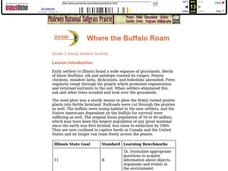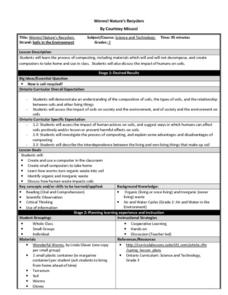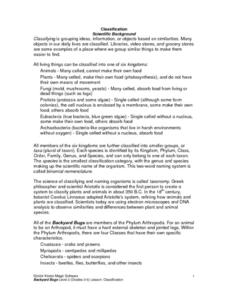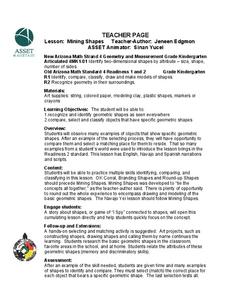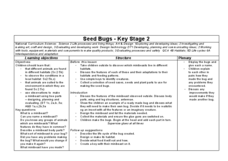Curated OER
Study of Animals
Third graders use the internet to research about an animal. After watching a demonstration, they follow the same steps to gain access to the internet as their teacher and find a picture of their animal to print. They complete a worksheet...
Curated OER
How Is A Frog Able To Swim In The Trees?
Fourth graders explore the interdependence of frogs and trees. They discuss the various things they need everyday to survive. Students select an animal from their local bioregion and research things that animal is dependent upon for...
Curated OER
When it is Wrong to Belong: Scavenger Hunt
Students participate in a scavenger hunt to find different types of trash items around different environments. They distinguish between man-made litter and natural materials.
Curated OER
Where the Buffalo Roam
Second graders explore what life in the Chicago area was like hundreds of years ago. They discuss how settlers impacted the environment, and why there are no longer herds of buffalo in the Chicago area today. They read an article and...
Curated OER
Skin: The Behavior and Health Connection
Middle schoolers explore how personal behavior can affect health, especially the health of your skin. They become better aware of how their personal behavior and the environment can have a considerable impact on their health in general....
Curated OER
A Home for a Cricket
First graders build a habitat for crickets after studying animal survival needs. They care for and observe the crickets in the classroom habitat.
Curated OER
Extinction Trade Questions
There are many ethical and moral issues surrounding critically endangered species. Use these higher-level thinking questions to help high schoolers examine ecological, socioeconomic, and political scenarios about human impacts on...
Curated OER
Patterns Everywhere!
Learners recognize and demonstrate the patterning of numbers and objects in our environment. They create a pattern using geometric shapes and find a missing number in a sequence.
Curated OER
Worms, Nature's Recyclers!
Young scholars study what worms need to survive in different environments. They study how worm composting improves soil and reduce waste. They discuss composting techniques and present a puppet show about a worm's life.
Curated OER
A Perfect Pond Study Lesson Plan
Learners take a field trip to a wetland ecosystem. An informal pond study is performed by students. They examine their favorite animal, write a description of how it moves and illustrate it. In groups, learners draw pictures of organisms...
Curated OER
Native Species Restoration: Is Saving One Species Hurting Another?
Learners investigate the effect of human activities upon the environment. The studying experience encourages students to think about the issues involved in native species restoration.
Curated OER
Comparing Mitosis with Meiosis
Life science learners view an online animated mini textbook comparing two types of cell division. Working in groups, they use a digital microscope to capture images of cells in different stages of mitosis and meiosis. Then they create an...
Curated OER
WET Science Lesson #11: How Light Affects Water
Scientists listen to the story of Wadja Egnankou who works to save African mangrove forests. They experiment with refraction and the introduction of particulate matter to water. They conclude with creative writing about the need for a...
Curated OER
Bears of Banff
Students pretend they have just entered a national park. They imagine that the park borders are all impassable mountains, and students will play the role of grizzly bears. Students list three things every animal needs to survive, in this...
Curated OER
Signed Number Operations and Absolute Value
Students examine methods for adding, subtracting, multiplying and dividing signed numbers. The observe animated illustrations of each operation. students discover the basic meaning of absolute value. They compute problems after instruction.
Green Learning
Build Your Own Biogas Generator
Where this is not exactly a lesson plan, it is a terrific outline of how to generate biogas from an animal manure sample. If you are up for the challenge, the generator can be built by your class as a concluding project at the end of an...
Curated OER
How We're Connected
Students take a survey in order to find out how they live in relationship to the environment. They take the time to investigate the differences between a need and a want. This is done as part of the self-assessment. Students also study...
Curated OER
Backyard Bugs
Explore the concept of scientific classification and the similarities and differences between plant and animal species. Your class will participate in hands-on activities by investigating dichotomous keys and classifying their shoes. To...
Arizona State University
Mining Shapes
Youngsters recognize and identify shapes. They draw, and use modeling clay to make shapes. They also identify shapes in their environment and in the Navajo culture, then compare the shapes and sort them into groups. This is the...
Indiana Historical Society
Lesson One – Vietnam War Time Line
To prepare for an in-depth study of the Vietnam Era, class members research and create a timeline that tracks the United States' involvement in Southeast Asia and especially Vietnam.
Curated OER
Birds of Prey
Students research various birds of prey on internet by following a worksheet with specific questions. Students answer questions on worksheet and write short response after completing research.
Curated OER
Seed Bugs; Stage 2
Students examine nature by participating in an environmental art activity. In this imaginary creature lesson, students discuss the importance of a habitat when pertaining to wild animals or bugs. Students utilize tree parts which they...
Curated OER
Water Regulation
High schoolers use their basic knowledge of physiology to analyze graphical data of paramecia under diverse conditions. From the data analysis, Students develop explanations of the animal's response to the concentration of different...
Curated OER
Name Match
In this name match worksheet, pupils match up and draw a line between fourteen birds and their formal names found within our environment.



